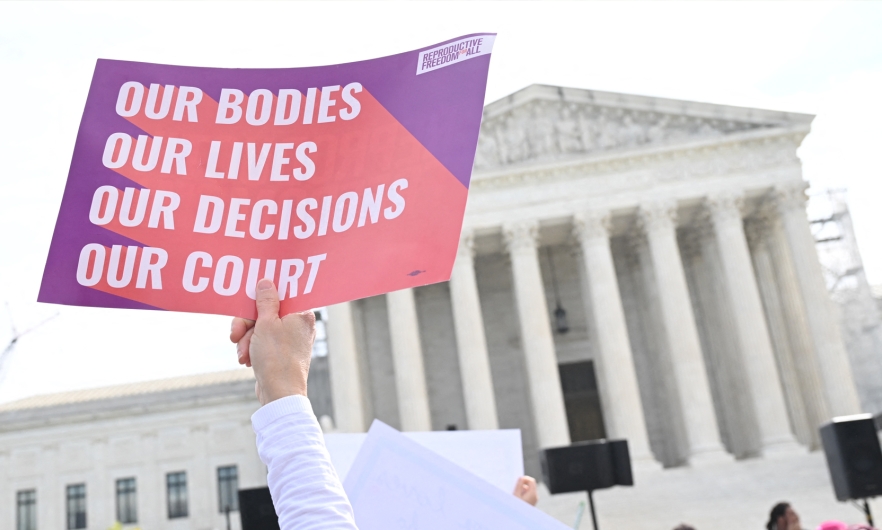Important Abortion Cases in a Holding Pattern Following SCOTUS Decisions
Mifepristone remains available, and EMTALA preempts Idaho's abortion ban, for now.

In June, the U.S. Supreme Court issued decisions in the two major abortion cases on its docket: one challenging the FDA’s approval of mifepristone, a common and long-proven-safe abortion medication, and another pitting state abortion bans against the federal emergency care law known as EMTALA.
For now, mifepristone remains on the market and a federal law requiring that hospitals provide stabilizing or lifesaving abortions is upheld. But the court’s decisions—both upholding the status quo—all but guarantee that both mifepristone and EMTALA will be under fire again in the future.
The path of mifepristone to the Supreme Court
In November 2022, a group of anti-abortion medical professionals known as The Alliance for Hippocratic Medicine sued the FDA in a Texas federal district court over its approval in 2000 of the abortion drug mifepristone and actions to expand access to the drug.
In early April 2023, the judge in that case ruled in agreement with the challengers and issued a preliminary injunction suspending the FDA’s approval of mifepristone and effectively halting its availability nationwide. Later that month, the U.S. Supreme Court issued a temporary order that allowed mifepristone to remain available for the duration of the appeals process.
SCOTUS heard arguments in the case—FDA v. Alliance for Hippocratic Medicine—in March 2024 and issued their decision on June 13.
What the court decided
In a unanimous opinion, SCOTUS dismissed the case on the basis that the plaintiffs who initiated the case did not have the necessary legal standing to bring this challenge in federal court in the first place.
Bringing a case in federal court requires more than disagreeing with a government’s or agency’s decision, Joanne Rosen, JD, MA, a practice professor in Health Policy and Management and an expert in reproductive law, explained in an episode of Public Health On Call. Rather, she explains, “you have to establish that you have suffered an injury that’s concrete and particularized—not hypothetical, not abstract—that the injury was caused by that government agency or the defendant, and that the court can address it with a remedy.”
In this case, “the coalition of plaintiffs were anti-abortion physicians and an anti-abortion medical association,” Rosen explains. “None of them prescribe mifepristone or perform abortions. None of them have been required by FDA action to do so.” Their suit only alleged that they could be impacted by the FDA’s approval of mifepristone in the hypothetical scenario that a person needed emergency care due to a complication from taking the drug, and that the plaintiffs would then have to provide care that violated their consciences.
What this decision means for the future of mifepristone access
The court did not address questions around the FDA’s actions or decisions related to mifepristone. The court also “didn't comment at all about the demonstrable and unequivocal evidence of the safety of mifepristone or anything about the appropriateness of the FDA regulatory decisions in this regard,” says Rosen, explaining that such commentary could have sent a signal that may have dissuaded potential future plaintiffs.
This means that mifepristone remains on the market, and the FDA’s regulatory decisions have not been affected. But it also means it’s possible—and likely—that the issue of the FDA’s regulation of mifepristone could come back before the court with different plaintiffs who assert that they have standing.
In fact, in January 2024, state attorneys general for Idaho, Kansas, and Missouri attempted to join the lawsuit against the FDA, but the Supreme Court denied it. “Those states all alleged that they have been harmed by the FDA’s regulation of mifepristone,” says Rosen. “So this case could move back through the court chain with Idaho, Kansas, and Missouri as plaintiffs.”
Even without further litigation, there are other ways mifepristone access in the U.S. could be restricted.
As part of their argument, the Alliance for Hippocratic Medicine claimed the FDA violated the Comstock Act in 2021 by allowing mifepristone prescriptions to be filled by mail. The Comstock Act is an 1873 law that made it a federal offense to transport by mail “obscene” materials, including any substance or device that can be used to produce an abortion.
And while the Act has long been considered unconstitutional or unenforceable, it was never repealed, and with enough momentum, it could be resuscitated and enforced. This could be done through the courts—a strategy that’s already gaining traction—or by a new administration pushing for stronger enforcement, including reversing the opinion that concluded mifepristone and misoprostol could be mailed.
How EMTALA made its way to the Supreme Court
Enacted in 1986, the Emergency Medical Treatment and Labor Act (EMTALA) is a federal statute that requires hospitals that receive Medicare funding to provide necessary stabilizing treatment to anyone who shows up to the emergency department, regardless of that person’s insurance status or ability to pay for treatment.
In July 2022, following the Dobbs decision, the U.S. Department of Health and Human Services reminded hospitals of their EMTALA obligations, including providing emergency abortions for pregnant patients who require them as stabilizing treatment, even if a state law would otherwise prohibit it.
“Where there's a conflict between providing stabilizing medical treatment under EMTALA and an abortion ban that allows abortion only in narrower circumstances, EMTALA will preempt the state ban,” Rosen explains.
In Idaho, abortion is banned except when it is necessary to prevent the death of the pregnant person. EMTALA, however, obliges hospitals to provide stabilizing medical care necessary to protect the health of a person, not just to prevent their death. In August 2022, the Department of Justice sued the state of Idaho. A preliminary injunction was granted that would allow the EMTALA obligations to prevail and allow an abortion in a situation when continuing a pregnancy seriously threatened a person’s health.
Idaho appealed to the Ninth Circuit Court of Appeals, which preserved that preliminary injunction. “Idaho then appealed to the Supreme Court, [which] in January agreed to hear this case before the Ninth Circuit would have heard its appeal in the ordinary course,” Rosen says. “They also, really importantly, blocked the preliminary injunction and allowed Idaho's ban to go into effect, notwithstanding the EMTALA obligations.”
What the court decided
On June 27, the court dismissed the case, saying they should not have agreed to hear the merits of this case prior to the Ninth Circuit holding its appeal and ruling. The case now returns to the Ninth Circuit to hear arguments.
The court’s opinion did not address the merits of the case—that is, the argument of whether EMTALA preempts the state’s law prohibiting abortion in situations where the two conflict.
What this means for emergency abortions in Idaho
For now, under EMTALA, a pregnant person who shows up at a hospital in Idaho and needs an abortion to prevent severe health consequences can receive one.
But this case is certain to return to the Supreme Court in the future, Rosen says. “However the Ninth Circuit rules—about whether EMTALA prevails or the Idaho ban prevails—one of the parties will appeal.”
In the meantime, there have already been real consequences. In the time between the Supreme Court’s block of the preliminary injunction in January—which allowed Idaho’s ban to take effect without regard for EMTALA—and its dismissal of the case at the end of June, six pregnant women had to be airlifted out of Idaho to other states in order to obtain the stabilizing abortions they needed. These patients are proof, Rosen says, “that when there is a conflict between the Idaho ban and EMTALA obligations, people may become so sick that they require emergency abortion care and cannot get it in Idaho.”
Another way EMTALA could return to the court
Currently in Texas, pregnant people in acute medical crises who require an abortion to stabilize their health have had to leave Texas to receive that care. That’s because in July 2022—after HHS reminded hospitals of federal EMTALA obligations—Texas sued the Department of Justice, and the Fifth Circuit Court of Appeals in Texas ruled in favor of Texas. According to their ruling, Texas’s strict abortion ban prevails over EMTALA obligations.
The DOJ has since filed for review of that Fifth Circuit opinion, and the Supreme Court has not yet decided whether to hear the appeal.
“One way or the other, this conflict with respect to EMTALA obligations will be back in front of SCOTUS,” Rosen says.
Aliza Rosen is a digital content strategist in the Office of External Affairs at the Johns Hopkins Bloomberg School of Public Health.
RELATED:
More from the Bloomberg School
- See latest headlines
- Learn more about our departments:





